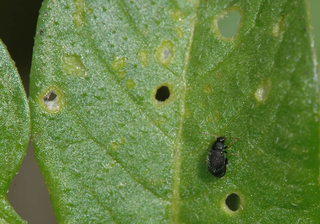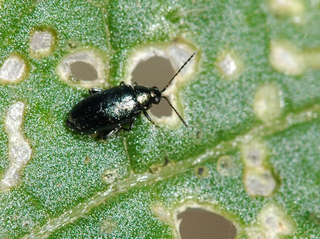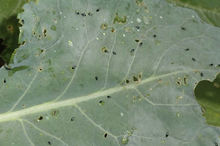How To Draw A Flea Step By Step
Quick facts
- Flea beetles are common pests found on many vegetable crops including radishes, broccoli, cabbage, turnips, eggplant, peppers, tomatoes, potatoes, spinach and melons.
- Flea beetles chew irregular holes in the leaves.
- Astringent flea beetle damage can result in wilted or stunted plants.
- Flea beetles are best managed through a combination of cultural and chemic control methods.
How to identify flea beetles
Virtually adult flea beetles are very pocket-sized (1/16 –1/viii inch long). An exception is the spinach flea beetle, which is one/4-inch long.
- Flea beetles tin be black, bronze, blueish or brown to metallic greyness.
- Some species have stripes.
- All flea beetles have large back legs which they use for jumping, peculiarly when disturbed.
The most common flea beetles in Minnesota:
- Crucifer flea beetle (Phyllotreta cruciferae)
- Striped flea beetle (P. striolata)
- Western black flea beetle (P. pusilla)
- Potato flea protrude (Epitrix cucumeris)
- Spinach flea beetle (Disonycha xanthomelas)
Most flea beetles feed on very specific plants, only the stake-striped flea beetle (Systena blanda) feeds on a variety of plants, like squash, beans, corn, sunflowers, lettuce, potatoes and many weeds.
Biology
- Flea beetles live through the winter as adults in foliage litter, hedgerows, windbreaks and wooded areas.
- Adult flea beetles become active in early spring. Depending on the species, females lay single or clusters of eggs in small holes, in roots, soil, or leaves of many vegetables as well every bit occasionally on flowers and ornamental shrubs and copse.
- Small white larvae hatch from eggs and feed on the roots of the newly planted seedlings.
- Larvae and so transform into pupae in the basis. At that place are normally one to two generations per twelvemonth.
Impairment caused by flea beetles
All types of flea beetles cause similar damage.
Crucifer flea beetle damage on turnips
- Adult flea beetles cause the near harm by feeding on the leaves and stems.
- They create shallow pits and small rounded, irregular holes (commonly less than 1/eight inch) in the leaves. This type of damage is unique to flea beetles.
- Plants started from seeds are less tolerant of feeding damage compared to transplants, but both can exist severely injured if flea beetle numbers are high.
- The larvae usually cause piddling to no damage to the plants (with the exception of irish potato flea beetle larvae).
Managing flea beetles in home gardens
|
Flea beetles are most damaging in jump. Information technology is important to monitor their activeness as presently as seedlings take emerged.
- Place yellowish viscous traps in your garden to run across if you take flea beetles.
- Cheque your plants for flea beetles and their damage.
- Foreclose astringent damage to your plants by treating seedlings when there are more than than five flea beetles per establish.
- Protect your crops if 10-thirty% of leaves on seedlings and transplants accept dropped off.
It is by and large not necessary to care for flea beetles during summertime, especially at the end of the season. By summer, crops reach the four- or 5-leaf stage and are stiff enough to survive feeding damage. The number of adult flea beetles also goes down at that time.
- Control weeds in and effectually planting sites to limit nutrient sources for flea beetles.
- Remove old ingather droppings and then that beetles volition not be able to get protection in the winter.
- Plant crops as tardily as possible. Plants grow faster in warmer temperatures and are more stable to resist impairment from flea beetles.
- Utilize row covers or other screening to go on beetles out when the seedlings are growing.
- Remove row covers before the flowers come up and then pollinating insects can reach the plants.
- Constitute a highly-favored crop, such as radish, as a trap crop, before you lot establish your principal crop.
- Adult flea beetles volition exist attracted to the tallest, earliest crops bachelor.
- In one case beetles are actively feeding on the trap crop, spray with a labeled pesticide.
Microctonus vittatae is a native braconid wasp (establish more usually in the eastern one-half of the U.S). This wasp kills the adult flea protrude. The larvae of this wasp develop on the female flea beetle and forbid the protrude from reproducing. They are not available for purchase.
There are many insecticides labeled for treating flea beetles. Be sure that the vegetable you wish to treat is listed on the characterization of the pesticide you intend to use. As well, be sure to observe the number of days between pesticide application and when you tin can harvest your ingather.
Beneath are names of agile ingredients that are usually bachelor in insecticides sold in stores that sell garden pesticides:
- pyrethrins/pyrethrum
- carbaryl
- malathion
- spinosad
- permethrin
- lambda cyhalothrin
- cyfluthrin
Flea protrude direction for farmers
|
- Shortly after planting, keep an eye out for flea beetle harm (beetles are highly mobile so looking for damage is easier).
- Feeding is similar across both plant and beetle species. Beetles leave numerous, pocket-sized (less than 1/8 inch) holes beyond leaves, often referred to as "shothole" impairment.
- Yellow viscous cards tin can likewise be used to detect flea beetles.
Planting date
Planting later in the "normal window" may aid plants avert the first generation of flea beetles. For example, in cole crops, planting afterward can help avoid the overwintering of flea beetle generations. In potatoes, planting afterwards, with warmer temperatures, helps potato plants grow speedily, minimizing the impact of flea beetle feeding.
Sanitation
Remove crop debris subsequently harvest to prevent flea beetle feeding, hopefully reducing the strength of time to come generations. This is especially important at the end of the season, as cleaning upwardly will help reduce overwintering sites.
Trap crops
Trap crops can exist used as sacrificial planting that is intended to be highly attractive to insect pests and thus draw pests away from the main crop.
In cole crops, trap crops accept been studied and used with success in other states.
- Trap crops must exist planted earlier than the main crop to describe flea beetles into them (typically 7-xiv days in advance).
- Trap crops should exist planted to 10% of the crop surface area and tin be planted along the field edge or forth a single side of the field.
- Multifariousness is also of import, with studies in Washington finding Pacific Gold Mustard and Pac Choi to be most effective in drawing flea beetles to them.
- There have besides been studies suggesting that trap crops fabricated of 3 brassica species were more effective than those made of one or two species.
Row covers
As long as crops are being rotated, row covers can exclude flea beetles feeding. The row cover volition brand weeding difficult, and flea beetles may go under the cover whenever it is lifted. For eggplants, you will need hoops as the row comprehend cannot lay directly on the eggplant.
There are native parasitoids of flea beetles (due east.g., Microctonus vittatae Muesebec), though they are not very mutual. They are non available for buy.
Generalist natural enemies similar lacewing larvae have been observed feeding on flea beetles
Treatment on all cole crops is recommended when 10-xx% of a stand shows feeding damage. Seedlings are the most susceptible, though it volition also be important for crops where they feed on the harvestable portion of the crop. Treatment may be needed sooner where cole crops are started from seed every bit heavy infestations will destroy seedlings earlier they sally.
Eggplant seedlings are besides preferred past flea beetles. When plants are small (less than 3 inches), consider treatments when there are two beetles per plant. Equally they grow, they can tolerate more damage. When plants are 3-6 inches tall, the threshold is 4 beetles per constitute, and when they are more half dozen inches tall, an viii-beetle-per-institute threshold applies. Flea beetles will exist slower in cool conditions, scouting for them is easier on cool mornings.
Feeding damage and protrude populations can be spotty beyond a field (or along field edges) so spot-treatments inside fields tin can be effective, reducing insecticide apply and costs.
Kaolin clay tin provide a concrete barrier to feeding, though studies (and grower feel) with this method study mixed results. This will need to exist practical subsequently it rains.
To ensure proper employ of insecticides, refer to the Midwest Vegetable Production Guide.
Reviewed in 2022
Source: https://extension.umn.edu/yard-and-garden-insects/flea-beetles
Posted by: hendricksonfalmyst64.blogspot.com






0 Response to "How To Draw A Flea Step By Step"
Post a Comment